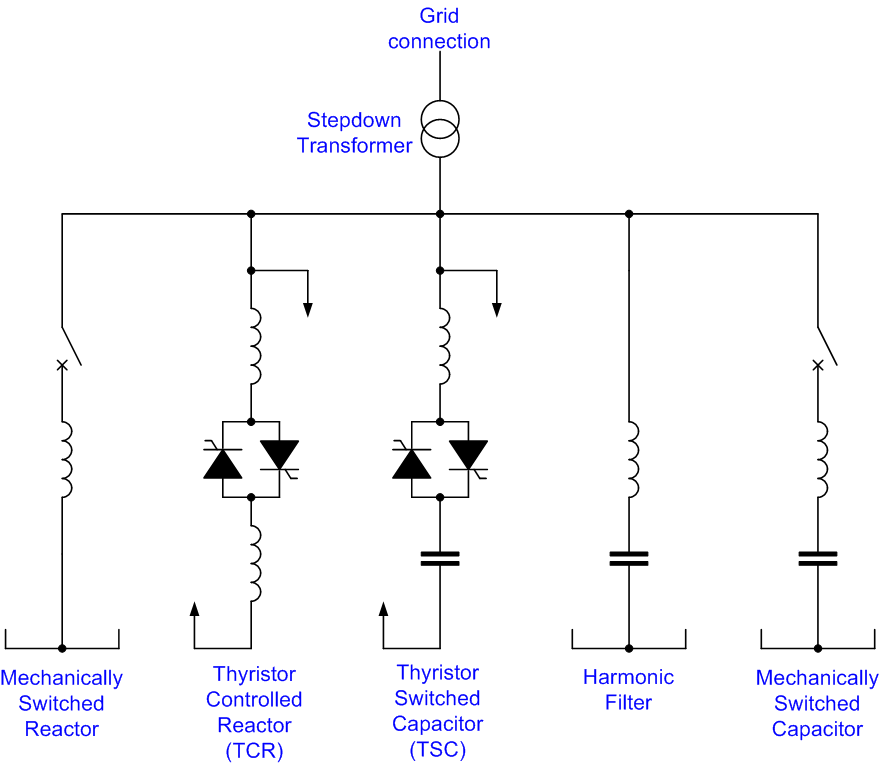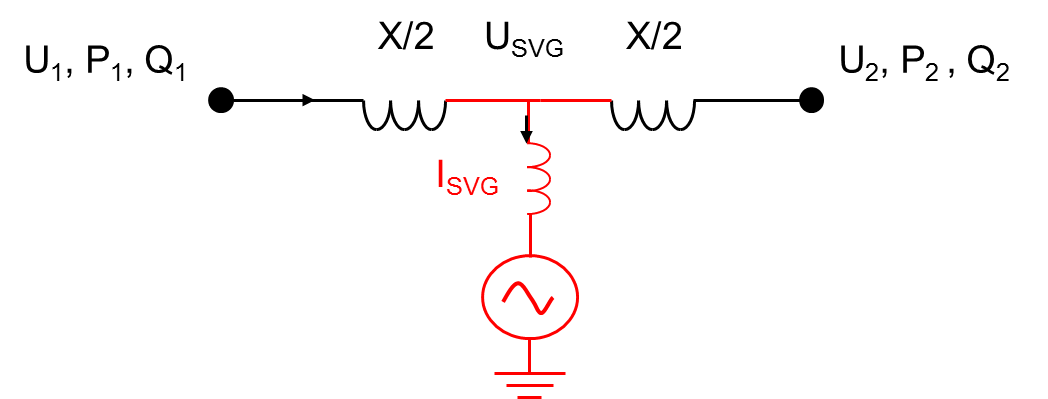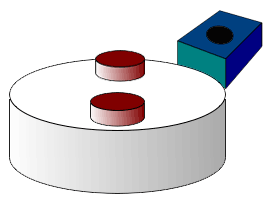|
Transductor
A transductor is type of magnetic amplifier used in power systems for compensating reactive power. It consists of an iron-cored inductor with two windings - a main winding through which an alternating current flows from the power system, and a secondary control winding which carries a small direct current. By varying the direct current, the iron core of the transductor can be arranged to saturate at different levels and thus vary the amount of reactive power absorbed. Transductors were widely used before the advent of solid-state electronics but today have been largely replaced by power electronic devices such as the Static VAR compensator and STATCOM. A formerly common use for Transductors was in CRT displays, to correct a distortion called pincushion distortion, where the side of the picture bowed in at the centre as a result of the geometry of large deflection angles. It would have one set of windings in the horizontal deflection circuit and the other set in the vertical; ... [...More Info...] [...Related Items...] OR: [Wikipedia] [Google] [Baidu] |
Saturable Reactor
A saturable reactor in electrical engineering is a special form of inductor where the magnetic core can be deliberately saturated by a direct electric current in a control winding. Once saturated, the inductance of the saturable reactor drops dramatically. This decreases inductive reactance and allows increased flow of the alternating current (AC). Design considerations Saturable reactors provide a very simple means to remotely and proportionally control the AC through a load such as an incandescent lamp; the AC current is roughly proportional to the direct current (DC) through the control winding. The power windings, the control winding, and the core are arranged so that the control winding is well isolated from the AC power. The AC power windings are also usually configured so that they self-cancel any AC voltage that might otherwise be induced in the control winding. Because the required inductance to achieve dimming varies with the size of the load, saturable reactors often ... [...More Info...] [...Related Items...] OR: [Wikipedia] [Google] [Baidu] |
Magnetic Amplifier
The magnetic amplifier (colloquially known as a "mag amp") is an electromagnetic device for amplifying electrical signals. The magnetic amplifier was invented early in the 20th century, and was used as an alternative to vacuum tube amplifiers where robustness and high current capacity were required. World War II Germany perfected this type of amplifier, and it was used in the V-2 rocket. The magnetic amplifier was most prominent in power control and low-frequency signal applications from 1947 to about 1957, when the transistor began to supplant it. The magnetic amplifier has now been largely superseded by the transistor-based amplifier, except in a few safety critical, high-reliability or extremely demanding applications. Combinations of transistor and mag-amp techniques are still used. Principle of operation Visually a mag amp device may resemble a transformer, but the operating principle is quite different from a transformer – essentially the mag amp is a saturable rea ... [...More Info...] [...Related Items...] OR: [Wikipedia] [Google] [Baidu] |
Reactive Power
Reactive may refer to: *Generally, capable of having a reaction (other) *An adjective abbreviation denoting a bowling ball coverstock made of reactive resin *Reactivity (chemistry) *Reactive mind *Reactive programming See also *Reactance (other) Reactance may refer to: * Electrical reactance In electrical circuits, reactance is the opposition presented to alternating current by inductance or capacitance. Greater reactance gives smaller current for the same applied voltage. Reactance is ... * Reactivity (other) {{disambig ... [...More Info...] [...Related Items...] OR: [Wikipedia] [Google] [Baidu] |
Iron
Iron () is a chemical element with symbol Fe (from la, ferrum) and atomic number 26. It is a metal that belongs to the first transition series and group 8 of the periodic table. It is, by mass, the most common element on Earth, right in front of oxygen (32.1% and 30.1%, respectively), forming much of Earth's outer and inner core. It is the fourth most common element in the Earth's crust. In its metallic state, iron is rare in the Earth's crust, limited mainly to deposition by meteorites. Iron ores, by contrast, are among the most abundant in the Earth's crust, although extracting usable metal from them requires kilns or furnaces capable of reaching or higher, about higher than that required to smelt copper. Humans started to master that process in Eurasia during the 2nd millennium BCE and the use of iron tools and weapons began to displace copper alloys, in some regions, only around 1200 BCE. That event is considered the transition from the Bronze Age to the Iron A ... [...More Info...] [...Related Items...] OR: [Wikipedia] [Google] [Baidu] |
Inductor
An inductor, also called a coil, choke, or reactor, is a passive two-terminal electrical component that stores energy in a magnetic field when electric current flows through it. An inductor typically consists of an insulated wire wound into a coil. When the current flowing through the coil changes, the time-varying magnetic field induces an electromotive force (''emf'') (voltage) in the conductor, described by Faraday's law of induction. According to Lenz's law, the induced voltage has a polarity (direction) which opposes the change in current that created it. As a result, inductors oppose any changes in current through them. An inductor is characterized by its inductance, which is the ratio of the voltage to the rate of change of current. In the International System of Units (SI), the unit of inductance is the henry (H) named for 19th century American scientist Joseph Henry. In the measurement of magnetic circuits, it is equivalent to . Inductors have values that typically ... [...More Info...] [...Related Items...] OR: [Wikipedia] [Google] [Baidu] |
Static VAR Compensator
A static VAR compensator (SVC) is a set of electrical devices for providing fast-acting reactive power on high-voltage electricity transmission networks. SVCs are part of the flexible AC transmission system device family, regulating voltage, power factor, harmonics and stabilizing the system. A static VAR compensator has no significant moving parts (other than internal switchgear). Prior to the invention of the SVC, power factor compensation was the preserve of large rotating machines such as synchronous condensers or switched capacitor banks. The SVC is an automated impedance matching device, designed to bring the system closer to unity power factor. SVCs are used in two main situations: * Connected to the power system, to regulate the transmission voltage ("transmission SVC") * Connected near large industrial loads, to improve power quality ("industrial SVC") In transmission applications, the SVC is used to regulate the grid voltage. If the power system's reactive load is capac ... [...More Info...] [...Related Items...] OR: [Wikipedia] [Google] [Baidu] |
STATCOM
A static synchronous compensator (STATCOM), originally known as a static synchronous condenser (STATCON), is a regulating device shunt-connected to alternating current electricity transmission network. It is based on a power electronics voltage-source converter and can act as either a source or sink of reactive AC power to an electricity network. If connected to a source of power it can also provide active AC power. It is a member of the FACTS family of devices, that became possible in 1990s due to availability of powerful gate turn-off thyristors (GTO). STATCOM is inherently modular and electable. These compensators can also be used to reduce voltage fluctuations. History and uses A prototype 1 MVAr STATCON was described in a report by Empire State Electric Energy Research Corporation in 1987. The first production 100 MVAr STATCON made by Westinghouse Electric was installed at the Tennessee Valley Authority Sullivan substation in 1995 and was quickly retired due to obsolesc ... [...More Info...] [...Related Items...] OR: [Wikipedia] [Google] [Baidu] |
Radial Distortion
In geometric optics, distortion is a deviation from rectilinear projection; a projection in which straight lines in a scene remain straight in an image. It is a form of optical aberration. Radial distortion Although distortion can be irregular or follow many patterns, the most commonly encountered distortions are radially symmetric, or approximately so, arising from the symmetry of a photographic lens. These ''radial distortions'' can usually be classified as either ''barrel'' distortions or ''pincushion'' distortions. Mathematically, barrel and pincushion distortion are quadratic, meaning they increase as the ''square'' of distance from the center. In mustache distortion the quartic (degree 4) term is significant: in the center, the degree 2 barrel distortion is dominant, while at the edge the degree 4 distortion in the pincushion direction dominates. Other distortions are in principle possible – pincushion in center and barrel at the edge, or higher order ... [...More Info...] [...Related Items...] OR: [Wikipedia] [Google] [Baidu] |
Hall Effect Sensor
A Hall effect sensor (or simply Hall sensor) is a type of sensor which detects the presence and magnitude of a magnetic field using the Hall effect. The output voltage of a Hall sensor is directly proportional to the strength of the field. It is named for the American physicist Edwin Hall. Hall sensors are used for proximity sensing, positioning, speed detection, and current sensing applications. Frequently, a Hall sensor is combined with threshold detection to act as a binary switch. Commonly seen in industrial applications such as the pictured pneumatic cylinder, they are also used in consumer equipment; for example, some computer printers use them to detect missing paper and open covers. Some 3D printers use them to measure filament thickness. Hall sensors are commonly used to time the speed of wheels and shafts, such as for internal combustion engine ignition timing, tachometers and anti-lock braking systems. They are used in brushless DC electric motors to det ... [...More Info...] [...Related Items...] OR: [Wikipedia] [Google] [Baidu] |



